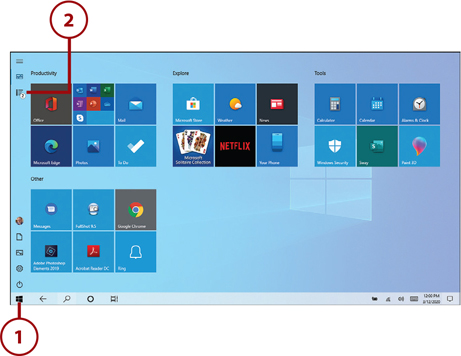8. Using Windows 10 on a Touchscreen or 2-in-1 Device

In this chapter, you learn how to operate Windows 10 on a touchscreen device.
![]() Using Windows with Touch Gestures
Using Windows with Touch Gestures
Many new PCs—both all-in-one desktop and laptop models—come with touchscreen displays. If your computer has a touchscreen display, you can perform many common operations by using your fingers to make special touch gestures on the screen. In addition, if you have a 2-in-1 PC that converts from a laptop to a tablet, you can use Tablet mode, which displays the Start menu and application windows full-screen.
Because Windows 10 was designed with touchscreens in mind, you can also perform many common operations with touch gestures, no matter which mode you’re in. You just have to know how.
Using Windows in Tablet Mode
If you have a traditional laptop or desktop PC, Windows is displayed in the normal desktop mode. If you have a 2-in-1 device with a touchscreen, however, Windows can display in Tablet mode, specially designed for devices you operate via touch instead of a keyboard or mouse. Tablet mode is optimized for smaller-screen devices, displaying the Start menu and all applications full screen.
Switch to Tablet Mode
If you have a 2-in-1 device, you switch to Tablet mode by following these steps.
![]() On the Windows taskbar, click or tap the Notification icon to display the Action Center.
On the Windows taskbar, click or tap the Notification icon to display the Action Center.
![]() Click or tap “on” the Tablet Mode tile. (It switches from gray to blue when activated.)
Click or tap “on” the Tablet Mode tile. (It switches from gray to blue when activated.)

Return to Normal Mode
To return to normal mode from Tablet mode, display the Action Center and click “off” the Tablet Mode tile.
Use Tablet Mode
Tablet mode is designed specifically for use with tablets and 2-in-1 laptops. In Tablet mode, the Start menu is displayed full screen, as are all open application windows. The taskbar remains visible so that you can easily open the Start menu, pinned apps, and open apps. And many apps—especially Windows apps—subtly adapt their interfaces for full-screen touch operation.
![]() Tap the Start button on the taskbar to display the Start menu full screen.
Tap the Start button on the taskbar to display the Start menu full screen.
![]() Tap the All Apps button to display all apps installed on your PC.
Tap the All Apps button to display all apps installed on your PC.

![]() Tap the Pinned Tiles button to display those tiles pinned to the Windows Start screen.
Tap the Pinned Tiles button to display those tiles pinned to the Windows Start screen.
![]() Tap any tile or icon to launch the associated program in full-screen mode.
Tap any tile or icon to launch the associated program in full-screen mode.

![]() Display the Action Center by swiping in from the right side of the screen or tapping the Notifications icon on the taskbar.
Display the Action Center by swiping in from the right side of the screen or tapping the Notifications icon on the taskbar.

![]() Switch to other open apps by swiping in from the left side of the screen and then tapping the app you want.
Switch to other open apps by swiping in from the left side of the screen and then tapping the app you want.

Using Windows with Touch Gestures
If you’re using Windows 10 on a computer with a touchscreen display, you can use your fingers instead of a mouse to do what you need to do. To that end, it’s important to learn some essential touchscreen operations.
Touchscreen Operations
Many operations in Windows 10 can be performed without a mouse or keyboard, using simple touch gestures instead.
![]() To “click” or select an item on a touchscreen display, tap the item with the tip of your finger and release.
To “click” or select an item on a touchscreen display, tap the item with the tip of your finger and release.
![]() To “right-click” an item on a touchscreen display (typically displays a context-sensitive options menu), press, hold, and then release the item with the tip of your finger.
To “right-click” an item on a touchscreen display (typically displays a context-sensitive options menu), press, hold, and then release the item with the tip of your finger.
![]() To scroll up or down a page, swipe the screen in the desired direction.
To scroll up or down a page, swipe the screen in the desired direction.
![]() To zoom in on a given screen (that is, to make a selection larger), use two fingers to touch two points on the item, and then move your fingers apart.
To zoom in on a given screen (that is, to make a selection larger), use two fingers to touch two points on the item, and then move your fingers apart.
![]() To zoom out of a given screen (that is, to make a selection smaller and see more of the surrounding page), use two fingers (or your thumb and first finger) to touch two points on the item, and then pinch your fingers in toward each other.
To zoom out of a given screen (that is, to make a selection smaller and see more of the surrounding page), use two fingers (or your thumb and first finger) to touch two points on the item, and then pinch your fingers in toward each other.
